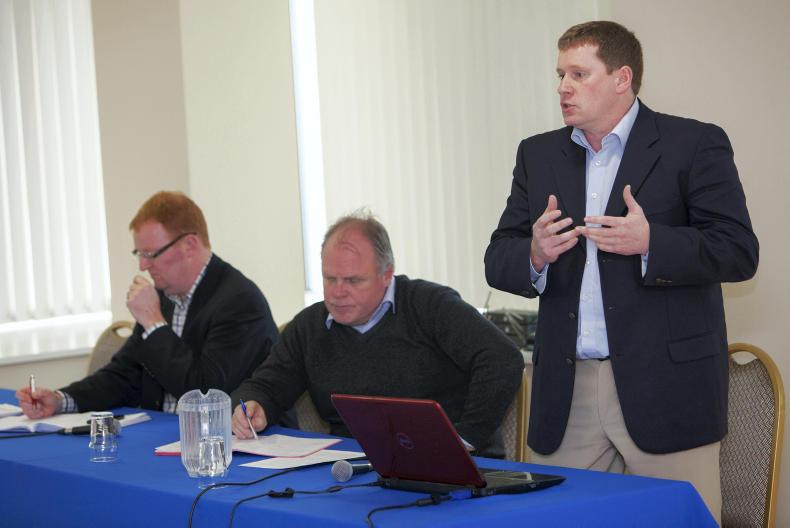The International Dairy Federation (IDF) World Dairy Summit 2019 took place in Istanbul, Turkey, this year. This annual international event brought together more than 1,000 delegates from around the world to discuss issues of interest in the dairy sector. Dairy producers, processors, experts, academics and policy makers exchanged ideas on topical issues in science, technology and innovation at this multi-stakeholder platform.
Dairy farmer Kevin Twomey from Ballyhooley in north Cork was one of the attendees, so I sat down with him when he arrived home to hear what he picked up from his meetings.
“This was my first time going to this conference and I found it particularly interesting to hear the different views from around the world.” Kevin said.

Kevin Twomey, dairy farmer, Fermoy, Co Cork.
“The difference between countries is very significant. As I listened to farmers around the room talking, it became very clear that some are coming from very different places.
“The way I see it, there are dairy problems in the EU and the US like animal welfare and lack of unskilled staff, but then in other parts of the world it’s more weather-related issues with milk suppliers in Africa and Asia.”
Supply chain issues
During the summit, while all these topics were discussed, plenty of industry integration issues were aired, including how the dairy farmer and industry link up on supply chain issues. Think about what happens at farm level and how it makes its way up the chain. Whether it’s chlorates in teat dip or disinfectants in parlours, they all have consequences further up the line. Antibiotic use in milking cows is a common issue, as mastitis is a problem around the world. Hormones in milk is another one – using them can drive yield per cow, but so can genetics.
The global future of dairy
In different countries, the dairy industry is at different stages of development. According to Kevin, some of the recurring questions were around protected urea and whether, as an industry, there is enough work done to ensure its safety further up the chain, along with glyphosphate residues, chemical residues and iodine residues, which can all make there way into the finished product.
“What government policy on dairy farming is has a direct bearing on how they view dairy in that country. As there is a general global convergence on cities, some governments have specific policies to keep rural parts of the country alive, and the dairy industry is seen as the saviour in these parts,” Kevin said.
“The carbon debate is high on the agenda for Ireland and New Zealand, but not on the priority list for other countries. Some have set out to achieve carbon zero by 2030, 2040 or 2050, but this will mean different things for different parts of the world. It will be easier in countries like France and Canada, where there are large tracts of underutilised or abandoned land. In Ireland, we are starting from a different position.”
Kevin explained that at the conference, a number of issues were highlighted from different countries, which show the different stages of development.
Danish-owned Arla is trying to make the EU consumer support the story behind dairy. A quick Google search for “Arla dairy story” will bring up the company’s promise to aim for net zero carbon by 2050. As a company, it is clear that for the last decade price volatility was the challenge and now for the next 10 years it’s climate, nature and ethical issues, alongside the benefits of milk products in the diet.
Speakers from Dutch multinational Friesland Campina came across very strong on nutrition and how they have planet proof farmers, so if it tastes good and is healthy for you, then they want to keep pushing that.
In China, the main focus is on consuming more dairy, so it will continue to be the growth country for dairy products. The numbers suggest a 48% increase in dairy consumption from a very low base, as they are going from consuming 25 litres to 34 litres of milk equivalent per year. That’s 75 million tonnes of milk powder per year.
There is a strong belief in many families in China that drinking more milk makes children smarter. As many young people spend a lot of time on laptops and smartphones, drinking milk is seen as a way to help improve eyesight and create faster cognitive function.
In India, the aim is to double milk production, which is huge, but it means doubling very small farms from one– and two–cow farms to three– and four–cow farms.
In Norway it’s all about ecotourism – rural tourists are important to the country and good dairy equals a good rural economy.
Host country to the conference Turkey has doubled production in 10 years, as the government is subsidising it a lot and now the government objective is to bring 750,000 cows (80m people) to over 1m cows. Remember it’s the eighth biggest wheat producer and imports south American and Irish cattle for fattening every year. Most parts of the country only get 25 inches of rain and any dairy produced is indoor production from maize, and wheat diets etc.
“It is always interesting to hear what others have to say and what issues they have. One of the take-home messages for me is that we need to set the standard for what is grass-fed. Dried grass is hay, but it is up to Ireland to set it up properly and collectively we need to sell our story because we have a very unique product,” Kevin said.
The International Dairy Federation (IDF) World Dairy Summit 2019 took place in Istanbul, Turkey, this year. This annual international event brought together more than 1,000 delegates from around the world to discuss issues of interest in the dairy sector. Dairy producers, processors, experts, academics and policy makers exchanged ideas on topical issues in science, technology and innovation at this multi-stakeholder platform.
Dairy farmer Kevin Twomey from Ballyhooley in north Cork was one of the attendees, so I sat down with him when he arrived home to hear what he picked up from his meetings.
“This was my first time going to this conference and I found it particularly interesting to hear the different views from around the world.” Kevin said.

Kevin Twomey, dairy farmer, Fermoy, Co Cork.
“The difference between countries is very significant. As I listened to farmers around the room talking, it became very clear that some are coming from very different places.
“The way I see it, there are dairy problems in the EU and the US like animal welfare and lack of unskilled staff, but then in other parts of the world it’s more weather-related issues with milk suppliers in Africa and Asia.”
Supply chain issues
During the summit, while all these topics were discussed, plenty of industry integration issues were aired, including how the dairy farmer and industry link up on supply chain issues. Think about what happens at farm level and how it makes its way up the chain. Whether it’s chlorates in teat dip or disinfectants in parlours, they all have consequences further up the line. Antibiotic use in milking cows is a common issue, as mastitis is a problem around the world. Hormones in milk is another one – using them can drive yield per cow, but so can genetics.
The global future of dairy
In different countries, the dairy industry is at different stages of development. According to Kevin, some of the recurring questions were around protected urea and whether, as an industry, there is enough work done to ensure its safety further up the chain, along with glyphosphate residues, chemical residues and iodine residues, which can all make there way into the finished product.
“What government policy on dairy farming is has a direct bearing on how they view dairy in that country. As there is a general global convergence on cities, some governments have specific policies to keep rural parts of the country alive, and the dairy industry is seen as the saviour in these parts,” Kevin said.
“The carbon debate is high on the agenda for Ireland and New Zealand, but not on the priority list for other countries. Some have set out to achieve carbon zero by 2030, 2040 or 2050, but this will mean different things for different parts of the world. It will be easier in countries like France and Canada, where there are large tracts of underutilised or abandoned land. In Ireland, we are starting from a different position.”
Kevin explained that at the conference, a number of issues were highlighted from different countries, which show the different stages of development.
Danish-owned Arla is trying to make the EU consumer support the story behind dairy. A quick Google search for “Arla dairy story” will bring up the company’s promise to aim for net zero carbon by 2050. As a company, it is clear that for the last decade price volatility was the challenge and now for the next 10 years it’s climate, nature and ethical issues, alongside the benefits of milk products in the diet.
Speakers from Dutch multinational Friesland Campina came across very strong on nutrition and how they have planet proof farmers, so if it tastes good and is healthy for you, then they want to keep pushing that.
In China, the main focus is on consuming more dairy, so it will continue to be the growth country for dairy products. The numbers suggest a 48% increase in dairy consumption from a very low base, as they are going from consuming 25 litres to 34 litres of milk equivalent per year. That’s 75 million tonnes of milk powder per year.
There is a strong belief in many families in China that drinking more milk makes children smarter. As many young people spend a lot of time on laptops and smartphones, drinking milk is seen as a way to help improve eyesight and create faster cognitive function.
In India, the aim is to double milk production, which is huge, but it means doubling very small farms from one– and two–cow farms to three– and four–cow farms.
In Norway it’s all about ecotourism – rural tourists are important to the country and good dairy equals a good rural economy.
Host country to the conference Turkey has doubled production in 10 years, as the government is subsidising it a lot and now the government objective is to bring 750,000 cows (80m people) to over 1m cows. Remember it’s the eighth biggest wheat producer and imports south American and Irish cattle for fattening every year. Most parts of the country only get 25 inches of rain and any dairy produced is indoor production from maize, and wheat diets etc.
“It is always interesting to hear what others have to say and what issues they have. One of the take-home messages for me is that we need to set the standard for what is grass-fed. Dried grass is hay, but it is up to Ireland to set it up properly and collectively we need to sell our story because we have a very unique product,” Kevin said.







 This is a subscriber-only article
This is a subscriber-only article










SHARING OPTIONS: